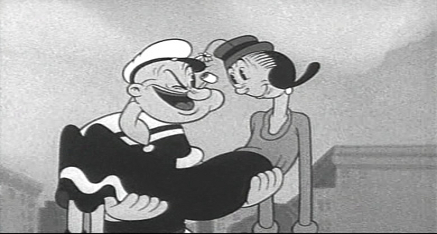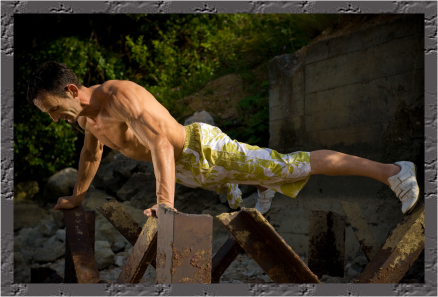Wrist Strengthening Exercises That Fit Folks Should Know

Ever stopped and wondered why Popeye, the incredibly strong spinach munching sailor, had such disproportionately large forearms? (yes, this is the stuff that keeps me awake at night) A strong grip is a likely result from working the muscles of the hands and forearms in a trade or profession that requires gripping things constantly, such as a concrete worker, a sailor like Popeye, or an aspiring super hero.

You’ve got to have some SERIOUS grip strength to be climbing a rope about the thickness of dental floss (And I still can’t figure out why they had to climb so close to each other…hmmm).
The hand and the forearm are made up of 35 muscles responsible for movement, and many of these muscles play a roll in gripping activities. A strong grip in itself may not seem like all that much to brag about, unless you like to leave people writhing in pain after handshakes (think grandpa strong), but a strong grip can heavily influence the amount of weight you’re able to lift for many of the most popular lifts. Weak hands are definitely not an obstacle that you should let keep you from building lean muscle.
It’s fairly obvious that hand strength has a significant impact in things like the strongman competition, arm wrestling, golfing, martial arts, gymnastics, and of course rock climbing, but hand strength also plays in significant role in less obvious pursuits such as those of musicians and desk dwellers (bloggers included). A 25 year study that was published in 1999 in The Journal of the American Medical Association concluded “that hand grip strength was highly predictive of functional limitations and disability 25 years later.” This means that those with good hand muscle strength earlier in life were less likely to develop disabilities later in life.
3 Basic Types of Grip Strength – A Brief Overview
1. Support Grip Strength – A grip requiring muscular endurance that is usually used when carrying something for an extended period of time. Often called the “farmer’s grip”, the best visual references for use in the gym is when doing exercises like dumbbell shoulder shrugs, deadlifts, and pull-ups.
2. Pinching Strength – The pinching grip is generally considered a weaker grip position. This grip is used when the fingers are on one side of an object while the thumb is on the other, but the object does not rest on the palm. This type of grip strength can be developed by holding two weight plates together in a pinch grip (smooth side out) until muscle failure.
3. Crushing Strength – Is what most people think of when someone mentions the word “grip”. The best visuals for this type of grip are handshakes, and in workouts is the grip that is primarily worked with grippers.
When I first started lifting I never gave a second thought to developing the strength of my grip, but as I progressed and began to lift heavier and heavier weights, I began to notice that my hands would start fatiguing before the muscles I was working. Hand and grip fatigue is a real pain in the arse that can leave you stranded on a muscle and strength growth plateau for what seems like an eternity (holy nightmare!). It’s damn near impossible to take your deadlifts or lat pulls to muscle failure if your grip gives out before your able to perform a sufficient amount of reps. If you’re suffering as I have suffered, you have basically two options to overcome your current limitations. The first option is to start employing training methods that are specifically geared toward building your hand/grip strength, and the second option is to start using wrist straps.
Solutions
Grippers – Grippers are small exercise devices used to build crushing grip strength, and are actually relatively inexpensive. The devices were originally made with wooden handles in the early 20th century, and were fairly easy to close. The wooden handled grippers were soon replaced by the more familiar plastic handled grippers, which were massed produced and caught on quickly.
In the 1960’s Iron Man Magazine introduced their “Iron Man Super Heavy Grip Developer”, a device that relied on steel handles and that was much more difficult to close than its mass produced counterparts. In the past the general practice was to perform high repetitions with grippers, but this was primarily because grippers with significant resistance had not yet been developed. Typical routines with today’s “super” grippers are quite similar to most other exercises, with 8-15 reps per set being the norm.
Many of today’s grippers are made with steel or aluminum handles, and come in a variety of resistances. Heavy Grip offers a relatively inexpensive Heavy Grip grippers set that’s made up of 6 different grippers with resistances of 100, 150, 200, 250, 300, and 350 pounds. The popular Captains of Crush Hand Grippers
are available as well and come in resistances from 60 to 365 lbs. As your strength improves you’re able to graduate and move up to stronger and stronger grippers.
Straps – weightlifting straps come in a variety of brands, configurations, and price points, but the general principle of all are the same. The straps are wrapped around the bar that you’re lifting and then you place your hands over the top of the strap. The strap then binds your hands to the bar allowing you to focus more on the muscle(s) being worked, since it’s not up to only your failing grip muscles to maintain hold. Check out our Recommended Resources page for links under the heading “equipment” if you’re interested.

One of the reasons why I don’t like lifting straps as an ultimate fix is that they never really force you to improve your grip strength, since they basically do the grip work for you. It’s kind of like a kid that never learns to ride a bike for fear of taking off the training wheels. Don’t get me wrong, I do use straps and they’re great for pushing through limitations caused by wrist weakness, but they shouldn’t be used as a substitute for developing your grip strength as well. Doing lifts like deadlifts, lat pulls, etc without the aid of straps will help you develop greater wrist strength over time.
It’s important to note that simply focusing on training your closed grip muscles (flexors) can lead to the development of muscle imbalances, which in turn can lead to the development of tendinitis and/or carpal tunnel. For that reason it’s important to incorporate exercises into your workouts that utilize the opening grip muscles (extensors) as well.
Some simple opening grip moves include:
- Fist push-ups
- Reverse Wrist Curls – helps to stimulate the finger extensor fibers
- Coffee Can Lift – Take a container like a coffee can and fill the bottom with rocks. Place your hand inside the can and then extend your fingers to the edges until you can pick up the can.
The grip muscles may not be the most glamorous or popular muscles to work, but there’s no doubt they’re an unsung hero behind the many lifts we love. Whether it’s deadlifts, lat pulls, bicep curls, etc, developing your grip strength is definitely something to take seriously if you’re determined to grow your strength, and build lean muscle mass.
Sound Off!
Have you ever experience limitations caused by relatively weak grip in your fitness journey? Feel free to share some of the ways you’ve overcome these and other limitations in the comments section below, or say whatever flies your flag!
Motivational Quick Tip – 3Ds
- Drive – a compelling urge to put in work!
- Discipline – living your workouts and your life in accordance with your principles daily.
- Determination – being resolute in your movement toward an end, a goal, or a result, EVEN when the going gets tough.
Rock it!
-Matt
predictive of functional limitations and disability 25 years later.





My Dad used to keep those hand-grips around the house when I was a kid. Always had one in his hand. Great reminder about the importance of maintaining muscle balance, even in the hands.
Ha ha! My dad did too Greg! It used to piss me off that I could never close the damn things, so he’d give me the weight clips to work with. I felt like the man! 🙂
Good stuff, Matt. Check out http://dieselcrew.com for some awesome feats of hand strength.
Some CRAZY awesome stuff there Todd! Can’t wait to tear my first phone book. Thanks for stopping by and sharing!
Diesel Crew are ridiculous. I can’t even read that site without losing 2 hours of my time. Great post and great plug for Captains of Crush – a worthy grip strength tool.
I had grip problems at one point early in my career. I was always heavy and my grip used to fail me on pull ups. Deadlifts were not a good exercise for me either, nor were bent over barbell rows or shrugs. These days I use chalk for heavy deads, and straps for the heavier sets of shrugs since I shrug more than I pull. For everything else my grip strength caught up. I think it’s because I use dumbbells and barbell for everything and I’m constantly focused on improving it. I enjoy Captains of Crush, plate pinches, and farmers walks.
Haven’t tried using chalk yet, but I’ve seen loads of people using it at the gym I frequent. I might have to reach over and nab some of that and give it a whirl. 🙂
I’ve added a couple of routines for legs that have me doing lunges with some pretty significant weight, which as a consequence has really improved my grip thanks to the good old farmers grip.
Thanks for chiming in!
Great post. I did a boat load of rope climbs this morning. I find that wearing gloves makes the grip more difficult and also helps accelerate strength.
Thanks for sharing,
Peter
See I hated them in grade school, but now I’d love to have a ceiling high enough to work em. I’ve heard that they no longer have the ropes at many of the schools around here. Taken away all the danger, and all the fun! 🙂
Thanks for the visit!
-Matt
I could use some more support grip strength. I found this out as I hung from the pull up bar and damn near fell off…..
Oh no! I’m glad you made it out ok. 🙂